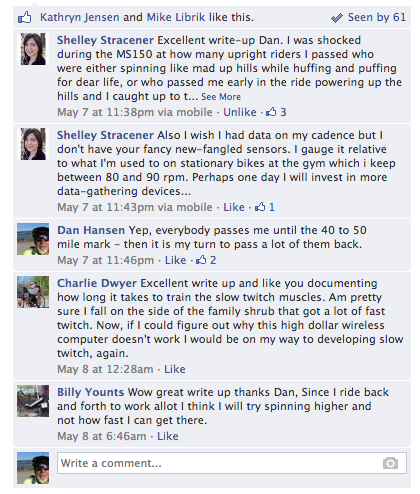A few months ago a friend of mine asked how to get his cadence above 60-70 rpms. I responded on FB with a pretty good layman’s explination of slow twitch and fast twitch muscles. Since I have a hard time remembering this stuff I’m posting it here so that I can find it later.
Billy Younts - Getting your cadence above 60 average for long rides.
Based upon looking at your garmin connect for the Caprock Escarpment Club Ride and your ride description below, it sounds like you are where I was about a year ago. When I first got my Musashi my cadenace was in the mid 60s and I cramped or bonked after about and hour and a half. Now my cadence is low 80s and I can ride a 100k, without stopping, easily in about 4 hours.
Your legs have two types of muscles: fast-twitch and slow-twitch.
Generally when your cadence is 60-ish you are using fast-twitch muscles. When your cadence is above 80 you are using slow-twitch muscles.
Fast twitch muscles are for sprinting (short spurts of extreme effort). Fast twitch muscles use the glycogen stored in the muscles. Muscle glycogen cannot be replenished at the rate you use it during a fast bicycle ride. Therefore, eventually during a ride you will use all the glycogen in your muscles and “bonk”. Typically your body stores about 90 minutes of glycogen - which at your speed translates into about the 35-40 mile mark during a ride. With correct on bike nutrition a person can delay bonking - but the body is only capable if digesting ~350 calories per hour and a hard fast ride can easily burn 700-900 calories per hour. The main objective on a long ride is to not run out of glycogen for your fast twitch muscles. And the only way to do that is to not use them.
Slow twitch muscles are for endurance (do not fatigue easily). Slow twitch muscles are very red due to their high level of capillarizention and rely on oxygen as their main energy source. As long as you are breathing correctly your slow twitch muscles can function at a high level for many hours.
If you were having hydration or nutrition issues your symptoms, and when those symptoms occur during the ride, would be different.
Although each person is genetically endowed with a certain percentage of slow twitch vs fast twitch muscles this genetical endowment does not really make much difference for the average club rider. At the club level any genetical advantage one person may have is easily overshadowed by another person’s perseverance and commitment to training.
The key here, as it was for me, is to develop your slow-twitch muscles. Unfortunately this involves a lot of hard work.
One day I just decided to start peddling at 80 rpm until I could not peddle at 80 rpm any more. My average speed dropped way down immediately. I could not breath enough to keep my heart rate at a reasonable level (remember slow-twitch muscles use oxygen for fuel). After 10 to 15 minutes I was back to peddling at 60 rpm, turning around and headed back home to recover.
I just kept doing this strategy, day after day, week after week. Gradually over time I could peddle at 80 rpm for a longer and longer time. My breathing improved, my resting heart rate dropped dramatically (43-46 bpm now).
After about a year of training 80 rpm is pretty normal for me now. On the last GASP 101 miler ride my average cadence was 82 rpm.
About 3 months ago I improved enough that I changed my strategy. Now I try to maintain 90 rpm constantly and when shorter steep hill climbing maintain 100 rpm. Longer hill climbing is at 90-95 rpm. Resting rpm is 70-75. Of course these are my current targets which I cannot maintain for very long. However, 80 rpm is pretty easy for me now-a-days.
Hope this helps.
Ready the full FB entry with people’s comments: https://www.facebook.com/groups/202233517257/permalink/10151589463522258/


